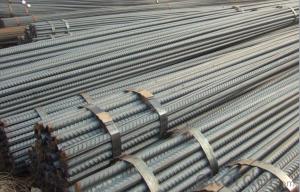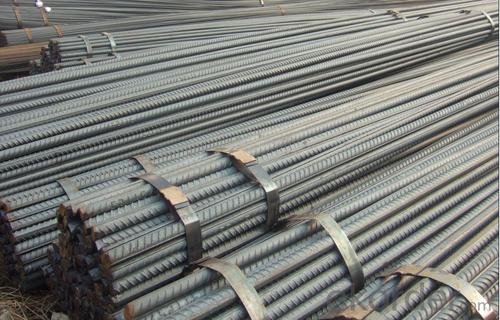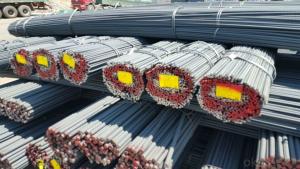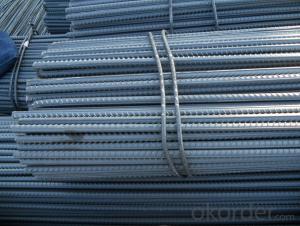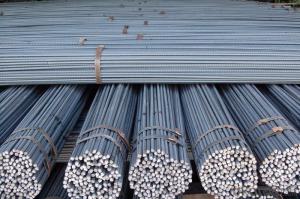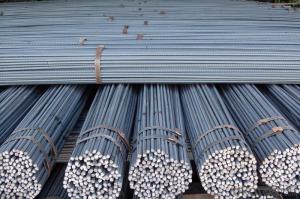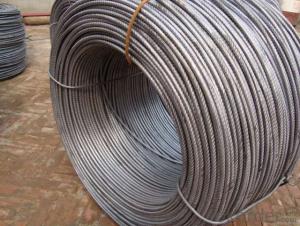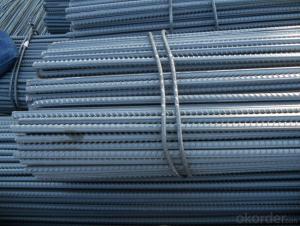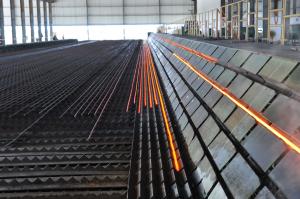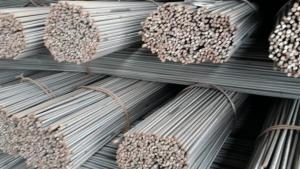GB Standard HRB400 Steel Deformed Bar 28mm/32mm
- Loading Port:
- Tianjin
- Payment Terms:
- TT or LC
- Min Order Qty:
- 50 m.t
- Supply Capability:
- 20000 m.t/month
OKorder Service Pledge
OKorder Financial Service
You Might Also Like
GB Standard HRB400 Steel Deformed Bar 28mm/32mm
Description:
-Standard: GB
-Material: HRB400
-Specification:
| Diameter(mm) | Section Area(mm2) | Mass(Kg/m) | Length(m) |
| 28 | 615.8 | 4.83 | 9, 12 or as customs' request |
| 32 | 804.2 | 6.31 | 9, 12 or as customs' request |
Chemical Composition(%) of GB Standard HRB400 Steel Deformed Bar 28mm/32mm:
| C | Mn | Si | S | P | V |
| ≤0.25 | ≤1.60 | ≤0.08 | ≤0.045 | ≤0.045 | 0.04-0.12 |
Mechanical Properties of GB Standard HRB400 Steel Deformed Bar 28mm/32mm:
Yield Strength (N/cm²) | Tensile Strength (N/cm²) | Elongation (%) |
≥400 | ≥570 | ≥14 |
Usage and Applications of GB Standard HRB400 Steel Deformed Bar 28mm/32mm:
Deformed bar is widely used in buildings, bridges, roads and other engineering construction. Big to highways, railways, bridges, culverts, tunnels, public facilities such as flood control, dam, small to housing construction, beam, column, wall and the foundation of the plate, deformed bar is an integral structure material. With the development of world economy and the vigorous development of infrastructure construction, real estate, the demand for deformed bar will be larger and larger.
Packaging & Delivery of GB Standard HRB400 Steel Deformed Bar 28mm/32mm:
Packaging Detail: products are packed in bundle and then shipped by container or bulk vessel, deformed bar is usually naked strapping delivery, when storing, please pay attention to moisture proof. The performance of rust will produce adverse effect.
Each bundle weight: 2-3MT, or as required
Payment term: TT or L/C
Delivery Detail: within 45 days after received advanced payment or LC.
Label: to be specified by customer, generally, each bundle has 1-2 labels
Trade terms: FOB, CFR, CIF
Images of GB Standard HRB400 Steel Deformed Bar 28mm/32mm:
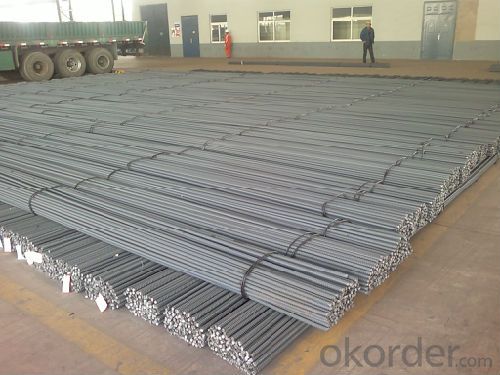
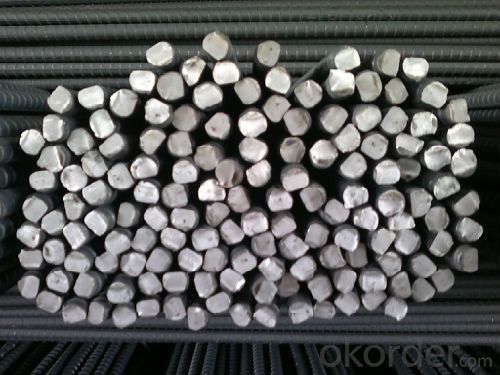
*If you would like to get our price, please inform us the size, standard/material and quantity. Thank you very much for your attention.
- Q: How do steel rebars affect the overall crack resistance of concrete structures?
- Steel rebars play a crucial role in enhancing the crack resistance of concrete structures. When embedded within the concrete, rebars provide reinforcement and increase the tensile strength of the structure. Concrete is inherently strong in compression but weak in tension, and steel rebars help overcome this weakness by absorbing the tensile forces that may cause cracks in the concrete. The presence of rebars in concrete structures allows for the redistribution of stress, preventing cracks from propagating and spreading. As the concrete undergoes shrinkage or experiences external loads, the rebars act as a reinforcement grid and help to resist the formation and expansion of cracks. By absorbing and distributing the tensile stresses, rebars ensure that the concrete remains intact and can withstand higher loads without significant cracking. Moreover, steel rebars also contribute to the overall durability of concrete structures. When corrosion of the rebars occurs due to exposure to moisture or other environmental factors, it can lead to an increase in volume, causing internal pressure and potential cracking of the concrete. However, the use of corrosion-resistant rebars, such as epoxy-coated or stainless steel rebars, can significantly mitigate this risk and improve the crack resistance of the structure. In summary, steel rebars enhance the crack resistance of concrete structures by providing reinforcement, increasing tensile strength, redistributing stress, and preventing crack propagation. Their presence ensures that the structure can withstand various types of loads and environmental conditions, improving both the strength and durability of the concrete.
- Q: How do steel rebars affect the overall lifespan of bridge structures?
- Steel rebars play a crucial role in enhancing the overall lifespan of bridge structures. By reinforcing concrete, rebars increase the tensile strength and structural integrity of the bridge, enabling it to bear heavy loads and withstand various environmental factors such as wind, earthquakes, and temperature fluctuations. This reinforcement prevents cracking, corrosion, and premature failure of the structure, ultimately extending its lifespan and ensuring the safety and reliability of the bridge for an extended period of time.
- Q: Excuse me, the difference between round steel, screw steel, steel, plate material, steel wire, hope professional answer
- The 2 plate and steel hot rolled steel plate, it is hard to know, the difference between rebar and rod easily screwed, clear, thread steel by chemical factory is a very deep rib.
- Q: What is the maximum length of a steel rebar available in the market?
- The maximum length of a steel rebar available in the market can vary, but it typically ranges from 60 to 80 feet.
- Q: What are the guidelines for inspecting and testing steel rebars on-site?
- The guidelines for inspecting and testing steel rebars on-site typically include visually examining the rebars for any visible defects such as rust, cracks, or bends. Additionally, non-destructive testing methods like ultrasonic testing or magnetic particle inspection may be employed to detect any internal flaws or inconsistencies in the rebars. It is also crucial to ensure that the rebars meet the specified dimensions, lengths, and quality standards as per the project requirements. Regular sampling and testing of rebars are essential to maintain the structural integrity and safety of the construction project.
- Q: Are there any alternative materials to steel rebars for reinforcement?
- Indeed, there exists a variety of alternative materials for reinforcement instead of steel rebars. One such material is FRP rebars, which consist of high-strength fibers like carbon, glass, or aramid embedded in a polymer matrix. These FRP rebars possess numerous advantages over steel rebars, such as a high strength-to-weight ratio, resistance to corrosion, and electromagnetic neutrality. They prove particularly valuable in situations where corrosion is a concern, such as marine environments or structures exposed to chemicals. Another alternative material is basalt rebars, which are formed by reinforcing basalt fiber with a polymer matrix. Similar to FRP rebars, basalt rebars offer advantages like a high strength-to-weight ratio and corrosion resistance. Additionally, they are non-conductive and non-magnetic, making them suitable for applications where electromagnetic neutrality is crucial, like in MRI facilities or near power lines. Besides FRP and basalt rebars, other alternative reinforcement materials include bamboo, timber, and composites made from natural fibers such as hemp or flax. These materials are commonly employed in sustainable construction practices or in regions where they are more easily accessible compared to traditional steel rebars. While they may not possess the same level of strength as steel, they can still provide adequate reinforcement for specific applications and offer other benefits like low environmental impact or ease of handling and installation. In conclusion, the availability of alternative materials to steel rebars provides engineers and architects with a range of options to select from based on their project's specific requirements, including factors such as strength, durability, cost, and sustainability.
- Q: Can steel rebars be welded to other steel components?
- Yes, steel rebars can be welded to other steel components. Welding is a common method used to connect steel rebars to various steel structures or components in construction projects. The process involves heating the rebars and the steel components to a high temperature, melting them, and then allowing them to cool and solidify, creating a strong and durable bond. Welding steel rebars to other steel components is a widely accepted practice that helps to enhance the overall structural integrity and stability of the construction. It provides a reliable connection between the rebars and the steel components, ensuring that they work together effectively to withstand the forces and loads placed on them. However, it is important to follow proper welding techniques and adhere to relevant industry standards and guidelines to ensure a successful and safe welding process.
- Q: What are the common grades of steel rebars?
- The common grades of steel rebars include Grade 40, Grade 60, and Grade 75.
- Q: What is the process of straightening steel rebars?
- To ensure proper alignment and eliminate any bends or deformities, steel rebars must undergo a series of steps during the straightening process. To begin with, a thorough examination is conducted to identify any visible defects like twists, kinks, or bends. This initial assessment is crucial in determining the extent of straightening required and whether any rebars need replacement. Once the inspection is finalized, the rebars are loaded onto a straightening machine. This machine features rotating rollers or hydraulic pressure devices that exert force on the rebars to realign them. The rebars are fed through the rollers or placed amidst the hydraulic devices, and gradual pressure is applied to reshape the bars and eliminate any bends or twists. During the straightening procedure, it is of utmost importance to maintain control over the applied force to avoid excessive straightening or further damage to the rebars. Skilled operators supervise the machine and adjust the pressure accordingly to ensure precise straightening. Following the straightening process, a final inspection is conducted to confirm that the rebars meet the required specifications. This inspection consists of checking for any remaining deformities, ensuring the rebars are of the correct length, and verifying that they are straight within acceptable tolerances. It is worth noting that the straightening process may vary depending on the type and size of the rebars. For larger or more complex rebars, different machines and techniques may be employed. Additionally, the process may involve preheating the rebars to enhance their malleability before straightening. All in all, the process of straightening steel rebars involves meticulous inspection, the utilization of specialized machinery, skilled operators, and a final inspection to ensure the rebars are straight, aligned, and ready for use in diverse construction projects.
- Q: How do steel rebars perform in seismic zones?
- Steel rebars perform well in seismic zones due to their high tensile strength and ductility. They are able to absorb and dissipate the energy generated during an earthquake, thus reducing the risk of structural failure. Additionally, steel rebars can be easily reinforced and adjusted to meet specific seismic design requirements, making them a reliable choice for construction in earthquake-prone areas.
Send your message to us
GB Standard HRB400 Steel Deformed Bar 28mm/32mm
- Loading Port:
- Tianjin
- Payment Terms:
- TT or LC
- Min Order Qty:
- 50 m.t
- Supply Capability:
- 20000 m.t/month
OKorder Service Pledge
OKorder Financial Service
Similar products
Hot products
Hot Searches
Related keywords
